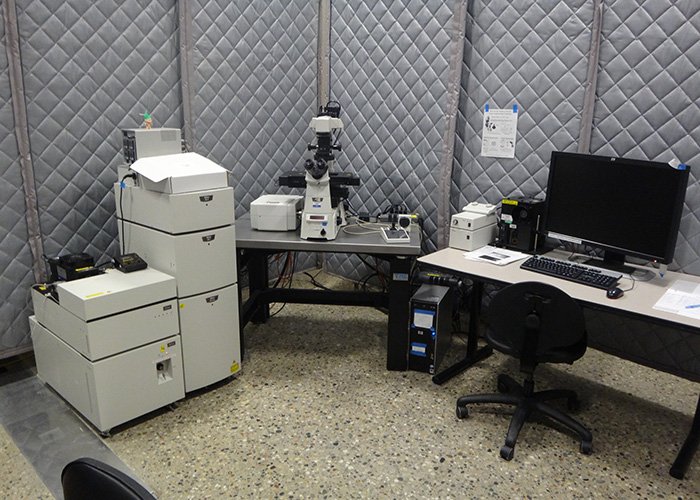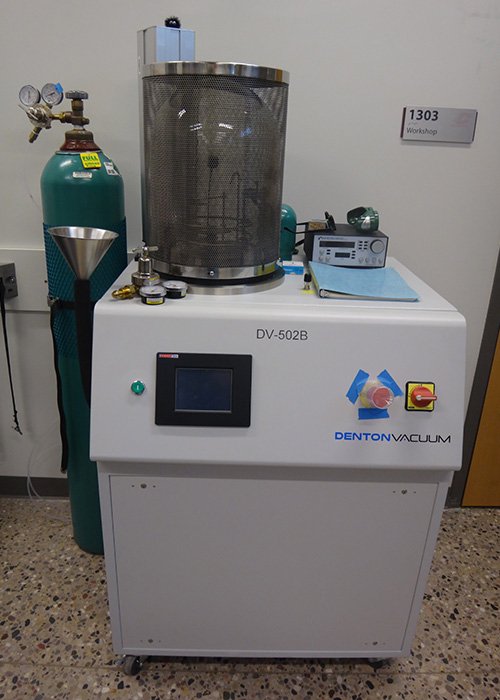Microscopy Facility
What is microscopy?
Microscopy is the science of using microscopes to magnify and visualize objects too small to be seen with the naked eye, such as cells, bacteria, tissues, and even nanoscale material structures. Using light, fluorescence, or electron-based imaging, microscopy reveals intricate details essential to biology, medicine, materials science, and many research fields.
Microscopy facility at Central Michigan University
The CMU Microscopy Facility gives students hands-on access to advanced imaging technologies right on campus. Whether you're studying cell structures, analyzing material samples, or working on an independent research project, this facility lets you explore the microscopic world with clarity and precision.
Hands-on microscopy training for student researchers
In the microscopy facility, you’ll work directly with state-of-the-art equipment, building valuable technical skills while deepening your understanding of complex scientific concepts. This experience prepares you for graduate programs, laboratory careers, and future opportunities in research-intensive fields.
Advanced imaging tools for cell and material analysis
From observing fine cellular structures to investigating physical properties of materials, the facility supports a wide range of academic and research needs. Students can apply microscopy techniques across disciplines including biology, biomedical sciences, chemistry, physics, and engineering.
Support from experienced microscopy staff
If you're ready to explore what’s possible or want help getting started, CMU’s microscopy team is here to guide you. Experienced staff members offer training, research support, and one-on-one assistance to help you succeed at every stage of your project.
Equipment

Hitachi HT7700 STEM
The Hitachi HT7700 STEM (Scanning Transmission Electron Microscope) is the newest instrument in the imaging facility.
It has a LaB6 emitter for a brighter beam, the EXALENS optional high-resolution lens, and does both transmission EM and scanning EM using a transmitted electron detector. The 7700 also has a Thermo-Noran System Seven energy-dispersive x-ray spectrometer with the silicon-drifter detector.
It can also do electron-beam diffraction for study of crystal lattices.

Nikon A1R CLSM
The NIKON A1R is the new scanning laser confocal light microscope (CLSM). It is based on a Nikon Eclipse inverted microscope, and has Differential Interference Contrast (DIC) optics. The A1R is the primary research confocal microscope.
This microscope uses a spectral detector for confocal scanning laser imaging, and also has a transmitted-light detector. Imaging capabilities include reflected-light confocal and transmitted-laser DIC imaging. It has 3 solid-state lasers and a dual-line argon gas laser, producing excitation lines at 403, 457/476, 488/514, 560, and 640 nm.
Objective lenses
4X, 10X, multi-immersion 20X, 40X oil-immersion, 60X water-immersion, and 60X oil-immersion.
Olympus Fluoview 300 CLSM
Students use our Olympus Fluoview 300 CLSM every day to learn confocal microscopy.
Our Confocal Laser Scanning Microscope is based on an Olympus BX50 upright microscope, and has Differential Interference Contrast optics and two extra-long working distance water immersion objectives on a special two position turret. A microinjection system for electrophysiological studies is also available.
This microscope is used in the Bio 553 Confocal Microscopy class. It uses three PMT detectors, two for epi-confocal imaging, and one for transmitted-light imaging. Imaging capabilities include reflected-light confocal and transmitted-laser DIC imaging. Argon 488 nm and He/Ne lasers are installed on the microscope.
Objective lenses
4X, 10X, 20X, 60X Plan Apochromat DIC; 40X Plan Fluorite DIC; 20X Plan Fluorite Long Working Distance Phase; 20X and 40X Plan Fluorite Water-immersion DIC
Micromanipulators
Narishige hydraulic hanging joystick-controlled fine and coarse micromanipulators

Hitachi 3400N-II Scanning Electron Microscope
The Hitachi 3400N-II has a tungsten filament electron gun with a large, motorized specimen chamber and has variable-pressure capability and an IR chamberscope. It is also equipped with a Deben cooling stage.
There are several detectors on this instrument: the usual secondary detector, a 5-element backscattered electron detector, an environmental secondary electron detector, a Thermo-Noran System Seven energy-dispersive x-ray spectrometer with a silicon-drift detector, and a Gatan color cathodoluminescence detector.
Other equipment
The imaging facility also has necessary specimen preparation equipment. We have Denton 502B carbon coater, an Anatech Hummer sputter coater, a SPI large-chamber critical-point dryer, and 2 RMC Powertome ultramicrotomes for producing thin sections for TEM.



Procedures
Preparatory equipment
Samples for viewing in microscopes, particularly biological samples, usually require special preparation methods. This is especially true of samples to be viewed in electron microscopes, where they must withstand high vacuums and bombardment with high-voltage electron beams.
These sample preparation methods typically use specialized instruments, available in the Imaging Facility:
- Ladd Research vacuum evaporator for carbon or metal evaporation.
- Denton Desk II sputter coater with either gold or 60/40 gold/palladium target.
- Polaron "bomb" critical-point dryer.
- 1 RMC Powertome and 2 MT-2B Sorvall ultramicrotomes.
- RMC GMK glass knife maker.
- Standard chemicals and equipment for fixing and embedding samples for confocal microscopy, SEM, and TEM.
- Equipment for freeze-fixation by plunging into liquid nitrogen and for making and plunge-freezing into slush nitrogen.
Light microscope cleaning procedures
Microscopes are sophisticated instruments that require periodic maintenance and cleaning. Dust, lint, pollen, dirt, and oil can cause a deterioration of image quality.
A few guidelines to follow:
- NEVER mix immersion oil types.
- ALWAYS clean immersion oil off oil lenses when you are finished with a scope (or at the end of a lab or end of the day).
- Immersion oil that is left on a lens or mixed with other oils can solidify and ruin the lens.
- Do not use cotton swabs (Q-tips and the like) to clean lenses! The cotton fibers will scratch lens coatings. Dacron and foam-tipped swabs are OK.
Major component routine cleaning
Oculars
- Routine disinfection of ocular to prevent transmission of conjunctivitis. Using a piece of non-linting lens paper soaked in 70% ethanol, lightly blot the surface to disinfect. Do not saturate the ocular! Air dry or use bunched lens paper to soak up the excess.
- Routine cleaning of oils and fingerprints and other contamination. First, use a duster and gently blow off the lens. Then, start with a bunched-up piece of non-linting lens paper dipped in lens cleaner (purple solution, aka Sparkle) and lightly blot the lens. Soak up any of the excess solution on the lens surface with fresh paper.
- Do not let the lens cleaner air dry! Remove it with a fresh, non-linting lens paper, very gently wiping the remaining lens cleaner from the lens, moving the paper in one direction (left to right, up to down, or the like). Use as much lens paper as needed to do the job.
Objectives
Clean following the same procedure above in Oculars. Extreme care should be given to cleaning the objectives, and this should only be done by an experienced user.
Stage
- Clean first with 70% ethanol and a Kim-wipe (not paper towels).
- If residue or contamination still remains, use the lens cleaner on a Kim-wipe to further clean the stage.
- Care must be taken not to saturate the moving parts of the stage when cleaning!
Body
- In general, the body of the microscope shouldn't need to be cleaned.
- The scopes are cleaned completely once a year.
- If it needs cleaning right away, follow the guidelines for cleaning the stage.
